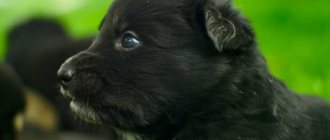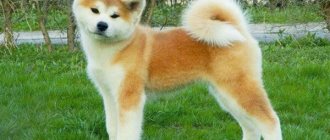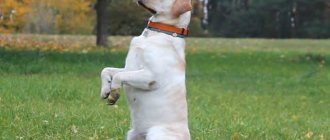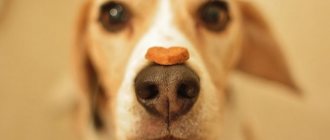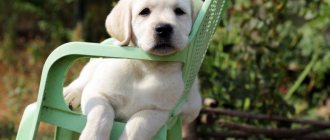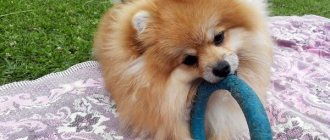Basic principles and goals of education
The dog's ancestors are pack predators. Modern stray dogs also form packs. Your pet understands the hierarchy in the group well. The owner for him is a leader, kind, but demanding. Therefore, it is important not only to develop affection in the dog, but also to become an authority for it.
The main thing is that education is constant and consistent. Otherwise, the puppy will not understand what is required of him. Designate and do not change the “dos” and “don’ts” that are mandatory for the dog. Small exceptions are allowed once she has firmly grasped the rules. Be predictable: the pet must understand what to expect from the owner.
A puppy, like any baby, wants to play. But it will not be possible to understand immediately what is allowed or prohibited. Try to secure the area around: remove wires, unstable and breakable objects, and household chemicals from access. Any things that can harm the pet or be harmed by its activity.
Choose a permanent place for feeding, buy special dishes for food and water. From the first days, teach him to take food only from a bowl or from the hands of his owners. This way you will avoid begging and stealing from the table. And at the same time, teach your pet not to eat anything and anywhere: it is not always safe. Keep feeding times: Fill the bowl with food at the same time every day. Remove it after 5-10 minutes so that the pet gets used to the regime.
The dog needs its own sleeping place. This is a personal territory where she will rest. You should not allow your pet to sit on the bed with people; it is very difficult to retrain him in the future. To prevent the puppy from being afraid of being alone in a new place, move his bed to the bed at arm's length. The baby will feel that you are nearby. He is used to sleeping with his mother and siblings - place a warm heating pad next to him the first night.
The longer you are with your pet, the stronger his attachment. Pay attention to communication and games. The dog does not understand words, but reads intonations perfectly. Talk to your pet: he knows that you are addressing him and is happy for the attention.
Whatever your dog does, don't yell at it. Reprimand firmly, in a low voice, looking intently at your pet. Screaming will only frighten him and prevent him from realizing his offense.
It is impossible to do without punishments, but they must be humane. The basis of good behavior is the expectation of reward from a person, and not the fear of punishment. You cannot intimidate or hit an animal.
"Bite" to explain something
Until you became its owner, the dog was commanded by the mother. To deal with a disobedient child, the animal world has its own way: the mother bites the puppy in the neck or simply rolls it onto its back.
A person can also use these same methods, but to imitate a bite, you need to tense your fingers and simply hit the neck with the tips, but only from above, where the skin is rougher.
If the behavior has not changed, then throw the naughty person on his back. It is possible that the pet will not understand the first time, but by the third time he will definitely realize that he is to blame.
Raising a dog: encouragement
A dog is happy when its owner pays attention to it. Affection and time spent together are no less desirable rewards than a treat. But the pet must learn: pleasure must be earned by fulfilling human demands. Even a small puppy should not be spoiled. Permissiveness and excessive encouragement lead to spoiling. The dog gets used to being capricious, begging, stealing food, and barking for no reason. Retraining an animal is much more difficult than raising it correctly. Good behavior needs to be rewarded to reinforce positive results. Stroke and scratch the puppy, play with him, give him treats. Conversing in a friendly, benevolent tone is also a sign of attention.
Lie
If your pet has learned the “sit” command, consider that he has almost learned the “lie down” command. We give the command “sit”, wait for the four-legged dog to fulfill it, after which we show him a treat in his hand, which we gradually move to the side at floor level. At this moment, when the animal begins to reach for the treat, we give the command “lie down” and press a little on the dog’s withers, preventing it from jumping up on its paws. The dog will reach for the hand with the treat and stretch into the correct position.
The second stage is to learn this command using a gesture (see figure). Add the gesture to the voice command when the pet begins to lie down on its own, without your hand on the withers. Then gradually increase the distance from which the dog executes the command.
Graphics: Dmitry POLUKHIN
Raising a dog: punishment
Even the most serious offense cannot be punished harshly. Such treatment makes your pet intimidated and destroys his trust in you. Your hands are a source of affection and treats for your puppy. He clings to his feet, seeking protection. Therefore, under no circumstances hit the dog or push it away with your foot. In order for the pet to understand its mistake and maintain affection for its owner, it is important to punish correctly.
- Timely: after 20-30 minutes the dog will not remember the offense and will not understand why you are angry. Do not punish immediately upon arriving home, even if you discover the consequences of the prank. The puppy has been waiting for a long time and is happy to meet him.
- Adequately: for similar offenses - the same punishment, for different ones - different.
- Do not call the puppy for punishment and do not lure it with a treat, come yourself. The owner's call should be associated only with positive emotions.
- Do not punish your pet on a bed or in a house: this is its territory. There he feels completely safe.
- Don't overdo it: Once the dog understands and obeys, stop the punishment.
- The pet perfectly understands looks, intonations, and gestures. Show how unhappy you are. Look closely and sternly, speak firmly and harshly. Make your voice lower and more threatening with every word. You can take the animal by the head and look into its eyes while reprimanding. Use short, understandable prohibition words: “ugh”, “quit”, “no”. But don't be intimidated: you need to achieve submission, not fear.
- Physical impacts should not cause pain or pose a danger to the health of the pet. Pull the leash and throw a soft, light object towards your pet. But never hit an animal.
- Attention Deprivation: Take your puppy to another room for a few minutes or refuse to play with him.
It is better to prevent bad behavior rather than punish it. Pay attention to your pet, buy him toys. Otherwise, the puppy will find something to do on his own, but you may not like the consequences. Monitor his health: behavior problems are often caused by poor health. In this case, you cannot punish the dog: it already feels bad.
Sit
Take a treat in your hand and bring your fist to your pet's face so that he can smell the smell. Slowly raise your hand up so that the dog reaches for the treat, lifting its nose. At this moment, intuitively, dogs most often sit down.
Voice the command. If the dog sits on his own, give him a treat. If not, repeat the command and lightly press your hand on the sacrum. After several such repetitions, the animals understand what is wanted from them.
Second phase. Once the dog begins to sit, it becomes simply unbearable to receive the coveted treat.
The dog may sit for a second or two, and then explode and begin wagging its tail, jumping and demanding a treat. At this moment you can’t give him anything. You need to sit the dog down again, wait about five seconds, and only then praise him for the exercise.
When the dog stops jumping up before receiving the treat, move on to the third stage. Along with voicing the command, show it with a gesture (see figure). A command is considered to be learned when the dog begins to execute it at a distance of 2–3 m.
Graphics: Dmitry POLUKHIN
Raising a dog through games and communication
Dogs are sociable animals. It is important for them to be close to their owner, play and walk with him. Even just watching his activities is a great joy. When you play with your puppy, you don't just have fun together. Communication and games strengthen the dog's attachment to the person and educate it. Play correctly so as not to develop aggressiveness and predator instincts.
- The initiator of the game is a person. The puppy must learn that choosing when and how to play is your privilege. Do not encourage harassment or attempts to distract you from your work.
- If the puppy shows aggression, stop playing. Do not allow your hands or clothing to be grabbed. Even if it doesn't cause serious discomfort. Bites from an adult dog that is used to grabbing with its teeth can cause injury. Banning them right away is much easier than retraining them. If the puppy gets too excited, give him a toy. Let him gnaw on her, not you. Scream loudly, but not angrily - the dog will understand that you are in pain.
- Stir up interest: interrupt the game at the peak of activity. Do not give your favorite toy into the puppy’s permanent possession: only play with it together. This will enhance the pleasure of having fun together.
- The opportunity to win develops the puppy's self-confidence. But never give in if the animal shows aggression.
What are social skills for?
There are many manuals on raising puppies for dummies. Of course, you can glean useful information from each source, but do not forget that each pet is individual, with its own characteristics, therefore, the approach must be individual.
Raising and training a dog are important stages in the life of the owner and the dog.
Before you figure out how to raise a puppy, you need to understand why an animal needs social skills. Social skills allow your pet to become an intelligent family member who:
- will be a faithful friend and guard;
- will relieve himself in the right place;
- will calmly receive guests;
- will not spoil things and steal food;
And so the list can go on ad infinitum.
Raising a puppy's distrust of strangers
A puppy often arouses the interest and affection of strangers. However, he must clearly understand: you need to trust only the owners. Do not allow strangers to pet your dog, much less give it treats. Until 6-8 months, most puppies are not aggressive and curious. Do not allow them to approach strangers, sniff them, or try to play. Ask to remove the dog from you if it is too affectionate. But don’t encourage aggression towards people and animals. They are taught to protect the owner using special training methods. But a protective dog should not show aggression without a human command.
Stand
It is better to learn this command when the dog learns to lie down when ordered. The lying position will be the starting position. The pet must be wearing a collar and on a leash. Lift your dog up by the leash until he stands on his paws. Voice the command and give a treat when the animal takes a stance. Treat him with a treat when the dog is standing upright, not trying to sit down on his butt.
Graphics: Dmitry POLUKHIN
Place and toilet training
Small breed dogs successfully learn to go to the toilet at home. Absorbent diapers or a special tray are suitable for this purpose. Medium and large pets will have to be taken outside. But not before all the necessary vaccinations have been given. Otherwise, the animal may contract an infection. While there are no vaccinations, use diapers.
By the age of 12-16 weeks, the puppy is already able to endure the toilet. Try to feed and remove the animal at the same time. The dog’s body will adapt to the established regime, and the pet will feel more confident. And you don’t have to remove unpleasant “surprises”.
Dogs are clean and will not go to the toilet near food. At first, limit the space around the puppy so that it can accommodate a bowl, but not enough space for the toilet. Monitor his behavior: as soon as the baby shows concern, take him to the toilet. Usually, in search of the required place, the dog barks, whines, scratches doors, walks around and sniffs corners. Don’t scold for a mistake: distract him with a clap of your hands, the word “no” - and urgently carry him to the diaper. If your pet did everything correctly, do not forget to praise and encourage him.
On the first day in your new home, set up a place for your puppy to sleep. It should be comfortable, warm and private enough to relax without interruption. But not isolated: dogs love to watch people. As soon as the baby is tired and wants to sleep, take him to the bed. Talk to him kindly, encourage him with words “good”, “well done”, “place”. Place a toy there to attract attention. Respect your dog's personal space: never disturb or punish him in his place. Only positive impressions should be associated with him.
Team Dai
An important command that will make your life with your dog much easier. Imagine that on the command “Give” the dog will let go of the object that he grabbed with his teeth. For example, your favorite shoes or mobile phone that you were going to chew on a little.
How to teach the "Give" command
This will be fun because the "Give" command needs to be taught as you play. Take a toy and excite the dog so that he grabs it with his teeth. Do not let go of the object and take it from the dog, accompanying this action with the word “Give.” Reward your pet with a treat for opening his teeth and allowing you to take the item. Repeat as many times as possible until the dog begins to give you the toy upon request.
Hygiene
Washing and cleaning must be taught from an early age. There are usually no difficulties in this. You just need to do everything carefully, without harming the baby. The water temperature should be comfortable for the dog; cold or hot water is not allowed. Then bathing will evoke only positive emotions, and the already mature dog will willingly run to the bathroom. This also applies to cutting or combing. The main thing is to be careful, because any pain and fear has its consequences. After some negative experience, the pet simply does not want to repeat the procedure again.
The most common mistakes owners make
Not all breeders know how to raise a puppy, and often make serious mistakes. First of all this:
- untimely start of training (too early or late);
- impermanence;
- lack of habit of finishing what you start;
- lack of composure - the breeder loses his temper and starts yelling at the puppy, which is not allowed.
By studying the owner's guide to raising a puppy, outlined above, and remembering the tips listed above, every breeder will be able to properly raise a pet and will not encounter unnecessary difficulties in the future.
Three signs of a true leader
Two biological species, man and dog, were created by nature for a harmonious existence in a hierarchical society. We will not argue whether the hierarchical ladder in human society is built fairly. But let’s take it for granted that in a pack of wolves, the closest relatives of dogs, it is built fairly. This is confirmed by scientists’ long-term observations of the behavior of wolves in a pack. And these are the important conclusions they drew for us.
The leader is not the one who is stronger
Physical strength is not always a sign of a leader; it is not without reason that a female can lead a pack. Sometimes the leader becomes neither the bravest nor the most experienced, but always the smartest - the one who is able to make the right decision in a difficult situation, and to whom all other animals can entrust their well-being.
The leader is always consistent and fair
It turned out that it is not immediately possible to visually identify the leader in a pack. It comes to the fore only when you need to make a decision and lead others, or when one of the animals violates peace and tranquility, crosses the established boundaries of behavior. The leader almost never uses force and does not even growl - a glance is literally enough for him to force him to obey. Finally, the leader always remains calm and confident.
The power of a leader is never based on violence
The famous wolf researcher Jason Badridze once observed such a picture. A pack of wolves was resting on the river bank, they all lay calmly on the grass, and several young animals settled down on a small hill - a place that is always occupied by the leader. When he appeared, the young wolves did not rush in all directions.
They noticed the approaching leader from a distance and, standing up calmly, “pretended” that they immediately needed to leave on important business. One went to drink water, another noticed something very interesting in the bushes, the third ran busily to the edge of the forest. All the wolves gave way to the leader, fully maintaining their dignity, without humiliation and servility.
Thus, the relationship between the leader and other members of the pack cannot be called the relationship of a master and a powerless slave; they are based on the voluntary recognition of the authority of one by all animals. Ideally, this is how raising and training a puppy should be - try to mentally try on the role of just such a leader.
Labrador training
The Labrador is a companion dog and is suitable for families with children. In order for you to have a wonderful friend, you need to have basic knowledge of how to train a Labrador. The puppy can be taught all the necessary commands at home.
Dogs of this breed completely trust a person, they do not expect nasty things from the trainer, so they can train for a long time and with great pleasure. They love human interaction, so they will happily accept a stroke or a kind word as praise instead of a treat.
The Labrador is a peace-loving dog; it will be less distracted during training with other animals, unlike fighting breeds. These dogs have a temperament - they cannot be called lethargic, but they are not impulsive, moderately active, with healthy motor activity - just what is necessary for successful training.
